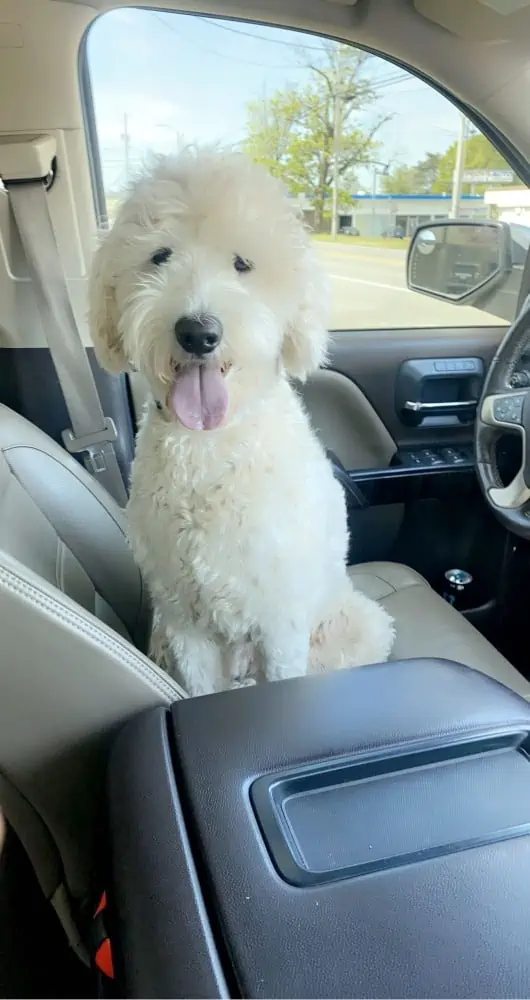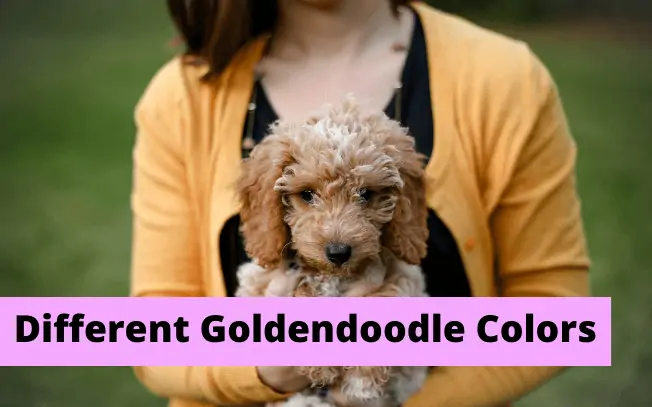Last Updated on
Goldendoodles, also known as “Groodles,” are beloved for their friendly and affectionate personalities, as well as their cute teddy bear-like appearance.
These dogs are a crossbreed of Golden Retrievers and Poodles, resulting in a vast range of colors and patterns.
In this article, we’re exploring different Goldendoodle colors and patterns that you might encounter, so get ready to discover all the variations these wonderful dogs have to offer.
12 different Goldendoodle colors
Goldendoodles, including the Standard Goldendoodle, Mini Goldendoodle, and Teacup Goldendoodle, are in high demand these days. And many people assume Goldendoodles are always golden in color—as their name implies.
However, you’ll be surprised to learn that Goldendoodle puppies come in various colors depending on their parents.
1. Apricot Goldendoodles
Apricot Goldendoodles inherit their coat color from both parents.
Many people give apricot Goldendoodles a teddy bear haircut as they look just like a teddy bear.
2. Red Goldendoodles
A red Goldendoodle is beautiful with its mahogany-shaded coat.
However, remember that the dark coat fades a little as the puppy grows and may appear more on the apricot side.
3. Cream Goldendoodles
Cream Goldendoodles are beautiful creamy coats that come from either the Poodle or the Golden Retriever parent.
Due to the coat’s cute look and beautiful color, cream Goldendoodles are in high demand right now.
The cream Goldendoodle is often confused with its golden or white cousins.
4. Black Goldendoodles
You may not know this, but Goldendoodle puppies come in black, too! A black Goldendoodle is rare and can look very much like a purebred Poodle—especially if it inherits the Poodle’s curly coat.
5. Gray Goldendoodles
Gray Goldendodles typically start out with black hair, and their hair changes colors from black to gray as they turn into an adult. Usually by the time they are two years old, they’ll be fully gray.
Once fully gray, they have a rustic silver look.
6. Blue Goldendoodles
A blue Goldendoodle doesn’t have a vibrant blue color—but a natural icy color with a combo of black and gray with a bluish tinge. This gives them a unique look—and that’s what makes blue Goldendoodles a rare breed!
The dog looks blue everywhere except in the stomach area. It’s easy to confuse them with a gray Goldendoodle, but the blue ones are born from many generations of breeding with blue Poodles.
7. Silver Goldendoodles
You may mistake a silver Goldendoodle with a gray or blue one, but it is much lighter than both its cousins. The first signs of silver hair appear when they are about 6 to 10 weeks old, but like gray Goldendoodles, will first start out with black hair.
Silver is one of the rarest Goldendoodle colors.
8. Silver Beige Goldendoodles
Silver beige Goldendoodles are a beautiful and rare color variation.
This unique coat color typically appears as a mix of light grey, silver, and brown, creating a stunning silver-beige hue.
9. Champagne Goldendoodles

Champagne Goldendoodle coats are a stunning and highly sought-after Goldendoodle color. This coat color typically features a light, creamy hue with hints of gold or apricot, resembling a glass of champagne.
10. Chocolate Goldendoodles
Chocolate Goldendoodles, also known as brown Goldendoodles, usually get their coat color from their Poodle side of the family. The American Kennel Club considers brown Poodles to be one of the most popular varieties.
11. Tan Goldendoodles
This coat color typically features a warm, golden tan hue that is similar to a Golden Retriever’s coat.
12. White Goldendoodles
White Goldendoodles inherit their color from the Poodle parents, as Golden Retrievers don’t come in pure white.
However, English Golden Retreivers do have very light fur that looks white. When you cross an English Golden Retriever with a Poodle you get an English Goldendoodle, which is a different breed than a regular Goldendoodle.
8 different Goldendoodle patterns
Having explored the diverse range of Goldendoodle coat colors, it’s now time to dive into the fascinating world of Goldendoodle patterns.
Each Goldendoodle’s coat is a unique combination of colors and patterns, some more common than others, such as black and white Goldendoodles.
However, many other multi-colored and patterned Goldendoodles are available for adoption, each with its own unique charm and character.
1. Tuxedo Goldendoodles
Tuxedo Goldendoodles derive their name from the pattern of their coat, which gives them the adorable appearance that they are wearing a tuxedo.
In this coat pattern, the white is concentrated in the belly, chest, and hindleg areas, while the colored part is usually in the front leg and back areas.
2. Merle Goldendoodles
Merle Goldendoodles have mottled color patches on their coat. Merle Goldendoodles can be various colors like black, white, and gray, brown, tan, and white.
Technically, a merle Goldendoodle is not really a Goldendoodle. The merle gene doesn’t occur naturally in Poodles, and merle Poodles have ancestors like a Border Collie or an Australian Shepherd.
While the merle gene can produce stunning coat patterns, the merle gene can also cause health issues, including hearing and vision problems, when two merle-carrying dogs are bred together. It’s important for breeders to carefully consider the genetic health of their dogs and to never breed two dogs together who are carrying the merle gene.
3. Parti Goldendoodles
A parti Goldendoodle has a coat with a combination of white and some other color, usually tan or apricot. The white section of the coat covers at least 50% of the Goldendoodle’s coat.
This color combination results from recessive genes, as one color overrides the solid shade of the hair. Thus, a parti-color Goldendoodle is extremely rare, and it is difficult to predict the color or pattern of a pup.
4. Abstract Goldendoodles
An abstract Goldendoodle is often referred to as the opposite of the parti Goldendoodle. That’s because the dog has a color pattern, with white appearing in less than 50% of the coat. This pattern is also referred to as mismark or chrome, and the dominant color can be any shade.
The white markings usually appear on the chest, face, and legs, in a random way, without following any specific pattern of colors.
5. Phantom Goldendoodles
Phantom Goldendoodles have a unique coat, with a combination of two colors in a specific pattern. The base color is the darker shade, while the lighter color appears in patches on the coat, specifically around the muzzle, eyes, and feet.
Black phantom Goldendoodle dogs with tan markings are the most common. But there are other phantom Goldendoodle variants with red and silver marks on the coat.
6. Brindle Goldendoodles
Brindle Goldendoodles usually come with a combination of black and red/brown, and the coat patterns are such that the black sections create stripes on the base color. This gives the dog’s coat an appearance similar to that of a striped tiger!
The stripes stand out against the lighter base, but not in all dogs. Sometimes, the stripes may hardly be noticeable! The patterns will vary in length and width.
7. Seal Goldendoodles
A seal Goldendoodle’s hair does something really interesting. These are black Goldendoodles that, due to some unknown reason, appear brownish or liver. However, unlike regular brown dogs, their nose remains black.
There’s no explanation as to why this phenomenon occurs in Goldendoodles.
8. Sable Goldendoodles
A sable Goldendoodle undergoes a miraculous change throughout its life. It is usually born as a black or chocolate Goldendoodle puppy, but the color fades, especially in the parts of the hair close to the skin.
Only the tips remain black or brown, and the base can be any of the other solid shades. But most commonly, you will notice tan or cream as the base color of this dog’s coat, with black/brown tips.
Why are there so many Goldendoodle colors?
So why are there so many Goldendoodle colors?
The answer lies in the genes.
When two different dog breeds are crossed, the puppies inherit genes from both parents, resulting in a unique combination of traits.
In the case of Goldendoodles, the coat colors are determined by the genes that the puppy inherits from the Golden Retriever and Poodle parents. Each breed has a different set of genes that control the coat color, and when they are combined, the offspring can exhibit a wide range of colors.
For example, Golden Retrievers typically have genes for yellow, cream, and red coats, while Poodles have genes for black, brown, apricot, and white coats. When these genes are combined, it results in a wide range of coat colors and patterns in Goldendoodles. Additionally, some Goldendoodles may inherit more genes from one parent than the other, resulting in more dominant coat colors.
It’s important to note that the color and pattern of a Goldendoodle’s coat can also change as they grow older. Puppies may be born with one coat color, and then as they mature, their coat may change to another color or pattern.
The rarest and most common Goldendoodle colors
The rarest Goldendoodle colors are blue, gray, and silver, resulting from multi-generational breeding, like a second-generation Goldendoodle (a.k.a. an F2 Goldendoodle).
Apart from these solid colors of the Goldendoodle puppy coat, two of the rarest patterns are parti and phantom.
The most common colors for Goldendoodles is, of course, brown/golden!
Changing colors
An unpredictable characteristic of Goldendoodle dogs is that they change the color of their hair over the years. This is not exactly a rare phenomenon, as many other purebred dogs and crosses also show similar changes in fur colors as they grow older.
Colors like red and its varieties may lighten after the dog reaches the age of two years. On the other hand, black or darker brown Goldendoodles may undergo silvering—and they develop blue-silver beige or silver shades.
The final color of the coat will depend on the genes.
If you’re wondering what color your Goldendoodle puppy might grow up to be, your breeder may be able to help. But quite often, the color remains unpredictable. Your Goldendoodle may not even change color, either—it may hold its puppy color.
Are Goldendoodle colors recognized by the American Kennel Club?
Major kennel clubs usually do not recognize designer dogs or crosses. So, Goldendoodles, a cross between Poodles and Golden Retrievers, do not have the recognition as a pedigree breed.
Hence, the clubs have no specification or standard to define the acceptable coat colors of Goldendoodles.
However, kennel clubs may soon start the process of recognition for crosses.
An alarming number of breeders cross dogs without getting the breeding stock tested and diseases may often go unidentified. Kennel clubs want to monitor the new breeds and start the process of crossbreed recognition to ensure their safe future in the hands of reliable breeders.
At the moment, though, only the parents of Goldendoodle dogs have recognized colors.
For Poodles, the American Kennel Club (AKC) recognizes black, white, silver, blue, gray, cream, apricot, red, and brown. In addition, the AKC recognizes various patterns, such as parti (two colors, one of which is white), phantom (two colors with specific markings), and sable (gradual blending of two colors).
Interestingly, The American Kennel Club (AKC) recognizes only one color for Golden Retrievers, which is the classic golden shade. According to the AKC breed standard, “rich, lustrous golden of various shades” is the only acceptable color for Golden Retrievers. Any other colors, such as cream, red, or mahogany, will get you disqualified in the show ring!
Effects of coat colors on a Goldendoodle’s health and behavior
There are myths and misconceptions regarding how the color of a Goldendoodle—or any dog as such—may affect its behavior. For instance, many people think that black dogs are aggressive and that lighter colored dogs are more docile.
However, there is no study that indicates any truth to this.
Goldendoodles are generally playful and warm, and their color has nothing to do with that. As for health issues—Goldendoodles, in general, face certain problems like hip dysplasia, Addison’s disease, subvalvular aortic stenosis, or cataracts. These conditions are not linked to their coat color. However, certain health conditions are linked to the color of Goldendoodles because of the gene pool.
For instance, Merle Goldendoodles are prone to blindness and deafness if both parent dogs carry the merle gene, which can happen in F2 Goldendoodles.
Final Thoughts
When considering adopting a Goldendoodle, it’s natural to have a color preference in mind. However, it’s crucial to prioritize the dog’s health and the breeder’s credibility over their coat color.
A Goldendoodle’s behavior is not linked to their color, so choosing a puppy based solely on their coat may not be the best approach. Ultimately, finding a reputable breeder and ensuring the health and well-being of your new furry friend should be your top priority when adopting a Goldendoodle!
What color is your favorite Goldendoodle color? Let us know below!
This article may include affiliate links. www.travellingwithadog.com is a participant of Amazon.com Services LLC Associates Program. As an Amazon Associate, I earn a commission from qualifying purchase. www.travellingwithadog.com participates in other affiliate programs, and recieves commissions when purchases are made through the links. The cost is not inflated to account for the commission earned.
Veterinary Disclaimer: travellingwithadog.com is not a substitute for veterinary advice and does not intend to provide any type of veterinary advice for your animals. Please consult your vet for any questions you have regarding your pets health.

About the Author:
Dana owns a Sheepadoodle and a rescue merle Labradoodle. Her first dog growing up was a white Toy Poodle and she’s loved dogs ever since. She has years of experience fostering dogs and has helped find homes for a variety of different breeds, both large and small! After seeing so many dogs end up unwanted and in shelters, she began blogging about different dog breeds (specifically Doodle dogs, since that’s what she knows best) to help people make informed choices when adding a new member to their family.
When Dana’s not brushing her Doodles’ hair (it takes a lot of time for two!) you can find her playing nose work games and fetch with her two amazing pups.
Learn more about her here.


I have a female goldendoodle that I absolutely love. She is a white and apricot parti doodle. So I guess that’s my favorite color!